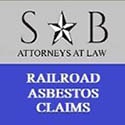
Railroads have been the backbone of industrial growth and urban development across the globe. They have facilitated trade, fostered economic growth, and connected distant regions. Despite their crucial role, railroads harbor hidden threats that have silently jeopardized the health of countless individuals. One of these threats is asbestos—a once widely used material known for its durability and insulating properties, now infamous for its detrimental health effects. This article sheds light on the presence of asbestos in railroads, its impact on workers, particularly those exposed before 1982, and the critical steps for asbestos removal. Furthermore, it will guide individuals affected by asbestos exposure on seeking legal assistance from specialized law firms like Sammons & Berry.
Asbestos is a naturally occurring mineral that was once hailed for its versatility. Its exceptional heat resistance and insulating capabilities made it a preferred choice in a variety of industrial applications, including the railroad industry. Trains, with their complex machinery and need for durable materials, often incorporated asbestos in brake pads, insulation, and even in the construction of railroad stations and facilities. Its use was so prevalent that it became a standard component in ensuring the efficient operation of rail systems.
However, the very properties that made asbestos attractive also contributed to its dangers. Asbestos fibers are incredibly fine and, when disturbed, can become airborne. This poses a significant risk, especially in environments like railroads where maintenance and construction activities are frequent. The lack of awareness about the risks of asbestos exposure during its peak usage meant that countless workers were unknowingly put in harm’s way, breathing in the toxic fibers that could lead to severe health issues.
The Risks of Asbestos Exposure
The risks associated with asbestos exposure are grave and multifaceted. When asbestos fibers become airborne, they can be easily inhaled or ingested, lodging themselves in the lungs and other tissues. This can happen during routine maintenance work, repairs, or even during regular operations when asbestos-containing materials deteriorate over time. The insidious nature of asbestos means that exposure is often unnoticed until it’s too late.
Prolonged exposure to asbestos fibers can lead to a range of serious health conditions. Asbestosis, a chronic lung disease, results from prolonged inhalation of asbestos fibers, causing lung tissue scarring and breathing difficulties. More alarmingly, asbestos exposure is a primary cause of mesothelioma, a rare and aggressive form of cancer that affects the lining of the lungs, abdomen, or heart. The latency period for asbestos-related diseases can span decades, making early detection and treatment incredibly challenging.
Impact on Railroad Workers
Railroad workers, particularly those employed before the implementation of stringent regulations in 1982, were disproportionately affected by asbestos exposure. During this period, safety measures were not as rigorous, and the use of personal protective equipment was limited or non-existent. Workers often handled asbestos-containing materials daily, unaware of the potential health hazards they were exposing themselves to.
The nature of railroad work—often involving the repair and maintenance of old equipment and facilities—meant that workers were regularly exposed to asbestos fibers. This exposure was not limited to direct contact. Asbestos could also be present in the air, settling on clothing and being carried home, thereby posing a risk to workers’ families as well.
Health Consequences
The health consequences of asbestos exposure are severe and often irreversible. Symptoms of asbestos-related diseases typically do not appear until decades after initial exposure, complicating the diagnosis and treatment process. Common symptoms include persistent coughing, shortness of breath, and chest pain, which can easily be mistaken for other respiratory conditions. Unfortunately, by the time these symptoms manifest, the disease is often advanced, leaving few treatment options.
The psychological impact on affected workers and their families can be profound. The realization that a long-past exposure could lead to life-threatening conditions adds a layer of stress and uncertainty. The financial burden of medical treatments, coupled with the loss of income due to illness, further exacerbates the challenges faced by these individuals. Early intervention and regular health screenings can help in managing these risks, emphasizing the need for awareness and proactive health measures.
Asbestos Removal and Safety Measures
The recognition of asbestos’s dangers has led to the implementation of strict regulations governing its removal and management. Asbestos removal, or abatement, is a meticulous process that requires identifying asbestos-containing materials and safely extracting them from structures. The complexity of this process demands specialized equipment and trained professionals who can ensure that asbestos fibers do not become airborne during removal.
Regulatory bodies have established comprehensive guidelines to protect workers and the public from asbestos exposure during removal. These guidelines mandate the use of protective clothing, respiratory protection, and the containment of asbestos materials to prevent contamination. Proper disposal of asbestos waste is also critical, requiring transportation to designated facilities equipped to handle hazardous materials safely.
Importance of Professional Asbestos Removal
The dangers of attempting to remove asbestos without professional assistance cannot be overstated. Untrained individuals risk disturbing asbestos fibers, significantly increasing the risk of exposure. Moreover, improper removal and disposal can lead to environmental contamination and legal repercussions, as many regions have strict laws prohibiting unauthorized asbestos removal.
Professional asbestos removal services employ advanced techniques and adhere to stringent safety protocols to minimize exposure risks. These services are equipped to handle the complexities of asbestos abatement, from initial assessment to final disposal, ensuring that affected areas are safe for future use. By choosing professional removal, property owners can protect themselves and others from the potential health hazards associated with asbestos exposure.
Legal Recourse for Affected Workers
For railroad workers exposed to asbestos before protective measures were implemented, seeking legal assistance is crucial. Law firms like Sammons & Berry specialize in representing individuals affected by asbestos exposure. These firms help clients navigate the complex legal landscape to secure compensation for medical expenses, lost wages, and other damages resulting from asbestos-related diseases.
Why Choose Sammons & Berry?
Sammons & Berry Law Firm has a proven track record of successfully representing asbestos exposure victims. Their team of experienced attorneys understands the intricacies of asbestos-related cases and is dedicated to achieving the best possible outcomes for their clients. By choosing Sammons & Berry, affected individuals can benefit from personalized legal strategies tailored to their unique circumstances.
The firm offers a compassionate approach, recognizing the emotional and financial toll that asbestos-related diseases can take on individuals and their families. Their comprehensive legal services include thorough case evaluations, gathering of evidence, and expert testimony to build a strong case for compensation. Sammons & Berry’s commitment to their clients ensures that they are supported throughout the legal process, providing peace of mind during challenging times.
Qualifying for Compensation
If you or a loved one were exposed to asbestos while working in the railroad industry, you might be eligible for compensation. The process begins by determining your eligibility, which involves assessing your work history, medical records, and the extent of asbestos exposure. Sammons & Berry offers a free consultation to evaluate your case and determine the best course of action.
Steps to Take
- Consult an Attorney: Reach out to a specialized law firm to discuss your situation and explore your legal options. The initial consultation can provide valuable insights into the strength of your case and potential compensation.
- Gather Documentation: Collect any relevant documents, including employment records, medical reports, and any evidence of asbestos exposure. Detailed documentation strengthens your case and helps establish a clear timeline of exposure and its impact.
- File a Claim: With the help of your attorney, file a claim to seek compensation for your injuries and losses. This step involves formalizing your case and presenting it to the responsible parties or their insurers.
- Negotiate a Settlement: Your attorney will work to negotiate a fair settlement with the responsible parties or take the case to court if necessary. This process may involve mediation or arbitration to reach an agreement that meets your needs.
Choose Sammons & Berry Law Firm
The legacy of asbestos in the railroad industry is a sobering reminder of the importance of workplace safety and the need for ongoing vigilance in protecting workers’ health. For those affected by asbestos exposure, legal assistance offers a path to justice and compensation. By understanding the risks and taking appropriate action, we can ensure a safer future for all workers. If you believe you have been affected by asbestos in the railroad industry, consider reaching out to Sammons & Berry for expert legal guidance and support.
Ensuring that history does not repeat itself requires a commitment to safety, transparency, and accountability. As we learn from past mistakes, we pave the way for safer and healthier working environments. For more information, visit https://railroadasbestosclaims.com/qualify/.
See if you qualify for compensation
Sammons & Berry, P.C.
800-519-1440
View our Google Listing


